check engine light Alfa Romeo 8C 2010 Owner handbook (in English)
[x] Cancel search | Manufacturer: ALFA ROMEO, Model Year: 2010, Model line: 8C, Model: Alfa Romeo 8C 2010Pages: 223, PDF Size: 14.35 MB
Page 35 of 223
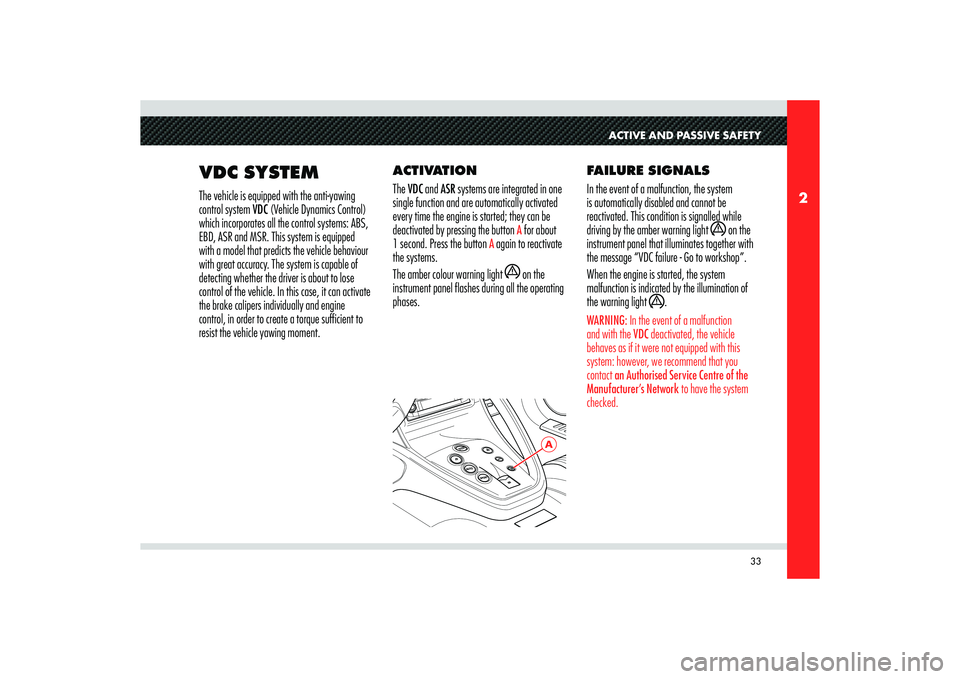
33
2
A
ACTIVE AND PASSIVE SAFETY
VDC SYSTEMThe vehicle is equipped with the anti-yawing
control system VDC (Vehicle Dynamics Control)
which incorporates all the control systems: ABS,
EBD, ASR and MSR. This system is equipped
with a model that predicts the vehicle behaviour
with great accuracy. The system is capable of
detecting whether the driver is about to lose
control of the vehicle. In this case, it can activate
the brake calipers individually and engine
control, in order to create a torque sufficient to
resist the vehicle yawing moment.ACTIVATION
The VDC and ASR systems are integrated in one
single function and are automatically activated
every time the engine is started; they can be
deactivated by pressing the button
A for about
1 second. Press the button
A again to reactivate
the systems.
The amber colour warning light
on the
instrument panel flashes during all the operating
phases.FAILURE SIGNALS
In the event of a malfunction, the system
is automatically disabled and cannot be
reactivated. This condition is signalled while
driving by the amber warning light on the
instrument panel that illuminates together with
the message “VDC failure - Go to workshop”.
When the engine is started, the system
malfunction is indicated by the illumination of
the warning light .
WARNING: In the event of a malfunction
and with the VDC deactivated, the vehicle
behaves as if it were not equipped with this
system: however, we recommend that you
contact an Authorised Service Centre of the
Manufacturer’s Network to have the system
checked.
Page 38 of 223
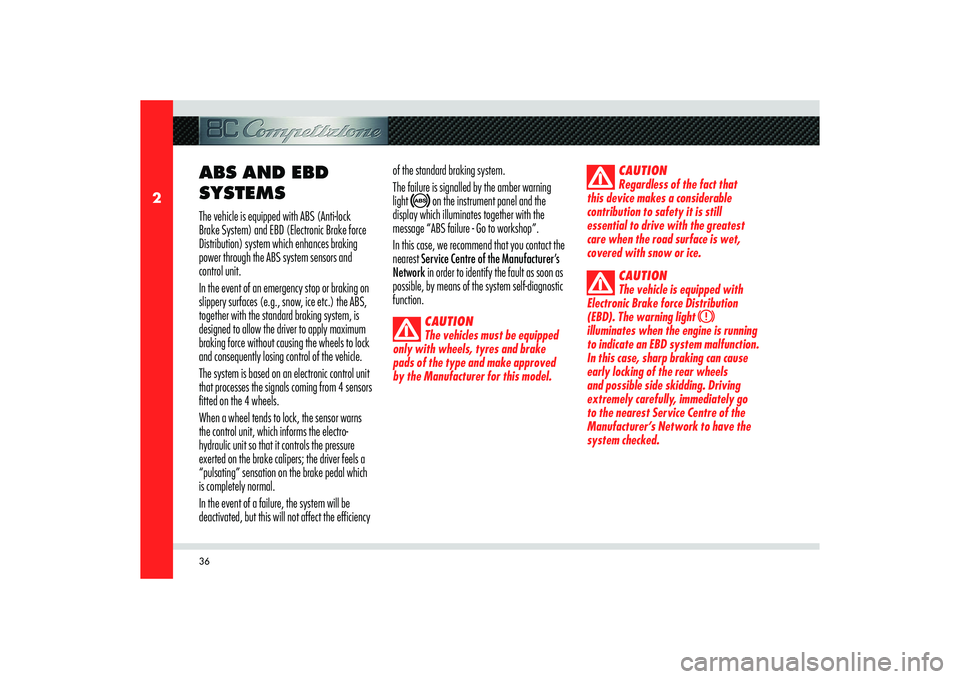
36
2
ABS AND EBD
SYSTEMSThe vehicle is equipped with ABS (Anti-lock
Brake System) and EBD (Electronic Brake force
Distribution) system which enhances braking
power through the ABS system sensors and
control unit.
In the event of an emergency stop or braking on
slippery surfaces (e.g., snow, ice etc.) the ABS,
together with the standard braking system, is
designed to allow the driver to apply maximum
braking force without causing the wheels to lock
and consequently losing control of the vehicle.
The system is based on an electronic control unit
that processes the signals coming from 4 sensors
fitted on the 4 wheels.
When a wheel tends to lock, the sensor warns
the control unit, which informs the electro-
hydraulic unit so that it controls the pressure
exerted on the brake calipers; the driver feels a
“pulsating” sensation on the brake pedal which
is completely normal.
In the event of a failure, the system will be
deactivated, but this will not affect the efficiency of the standard braking system.
The failure is signalled by the amber warning
light
on the instrument panel and the
display which illuminates together with the
message “ABS failure - Go to workshop”.
In this case, we recommend that you contact the
nearest Service Centre of the Manufacturer’s
Network in order to identify the fault as soon as
possible, by means of the system self-diagnostic
function.CAUTION
The vehicles must be equipped
only with wheels, tyres and brake
pads of the type and make approved
by the Manufacturer for this model.CAUTION
Regardless of the fact that
this device makes a considerable
contribution to safety it is still
essential to drive with the greatest
care when the road surface is wet,
covered with snow or ice.
CAUTION
The vehicle is equipped with
Electronic Brake force Distribution
(EBD). The warning light
illuminates when the engine is running
to indicate an EBD system malfunction.
In this case, sharp braking can cause
early locking of the rear wheels
and possible side skidding. Driving
extremely carefully, immediately go
to the nearest Service Centre of the
Manufacturer’s Network to have the
system checked.
Page 39 of 223
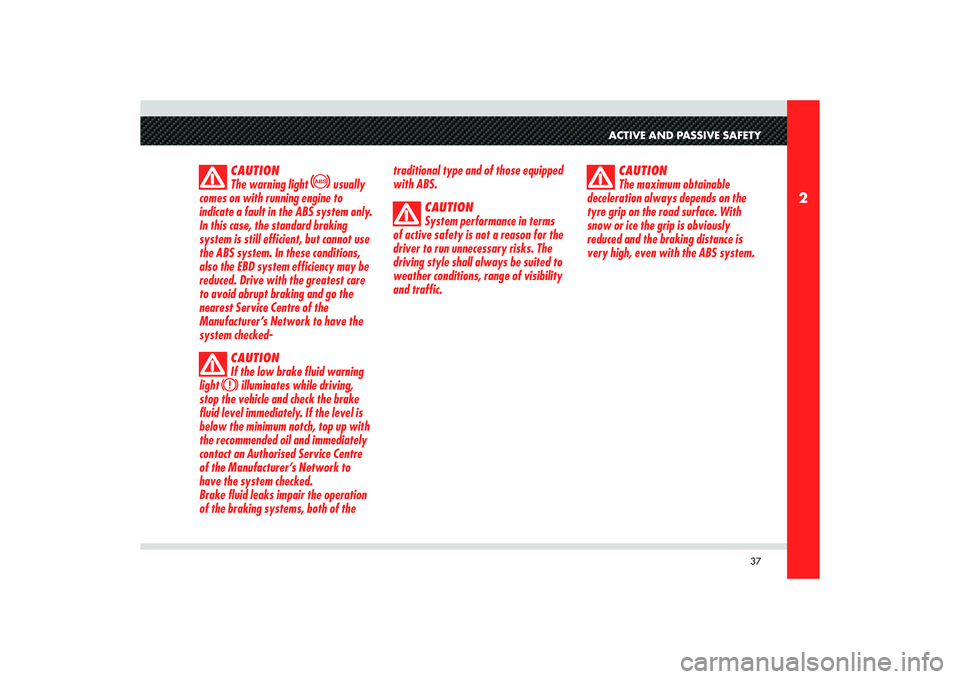
37
2
ACTIVE AND PASSIVE SAFETY
CAUTION
The warning light
usually
comes on with running engine to
indicate a fault in the ABS system only.
In this case, the standard braking
system is still efficient, but cannot use
the ABS system. In these conditions,
also the EBD system efficiency may be
reduced. Drive with the greatest care
to avoid abrupt braking and go the
nearest Service Centre of the
Manufacturer’s Network to have the
system checked-
CAUTION
If the low brake fluid warning
light
illuminates while driving,
stop the vehicle and check the brake
fluid level immediately. If the level is
below the minimum notch, top up with
the recommended oil and immediately
contact an Authorised Service Centre
of the Manufacturer’s Network to
have the system checked.
Brake fluid leaks impair the operation
of the braking systems, both of the
traditional type and of those equipped
with ABS.
CAUTION
System performance in terms
of active safety is not a reason for the
driver to run unnecessary risks. The
driving style shall always be suited to
weather conditions, range of visibility
and traffic.CAUTION
The maximum obtainable
deceleration always depends on the
tyre grip on the road surface. With
snow or ice the grip is obviously
reduced and the braking distance is
very high, even with the ABS system.
Page 40 of 223
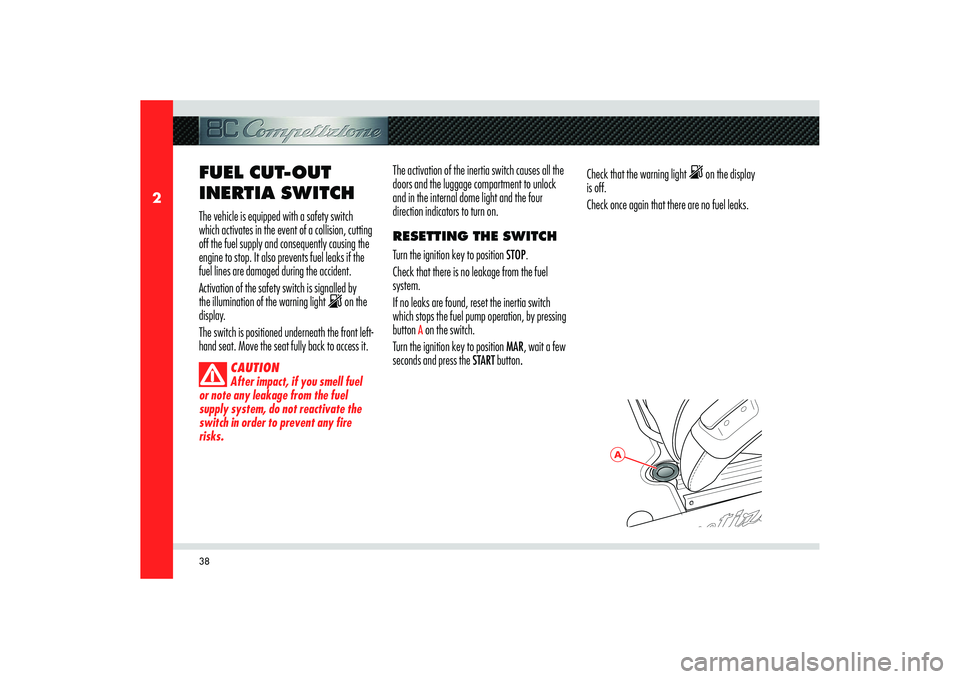
38
2
A
FUEL CUT-OUT
INERTIA SWITCHThe vehicle is equipped with a safety switch
which activates in the event of a collision, cutting
off the fuel supply and consequently causing the
engine to stop. It also prevents fuel leaks if the
fuel lines are damaged during the accident.
Activation of the safety switch is signalled by
the illumination of the warning light
on the
display.
The switch is positioned underneath the front left-
hand seat. Move the seat fully back to access it.
CAUTION
After impact, if you smell fuel
or note any leakage from the fuel
supply system, do not reactivate the
switch in order to prevent any fire
risks.
The activation of the inertia switch causes all the
doors and the luggage compartment to unlock
and in the internal dome light and the four
direction indicators to turn on.
RESETTING THE SWITCH
Turn the ignition key to position STOP.
Check that there is no leakage from the fuel
system.
If no leaks are found, reset the inertia switch
which stops the fuel pump operation, by pressing
button
A on the switch.
Turn the ignition key to position MAR, wait a few
seconds and press the START button.Check that the warning light
on the display
is off.
Check once again that there are no fuel leaks.
Page 63 of 223
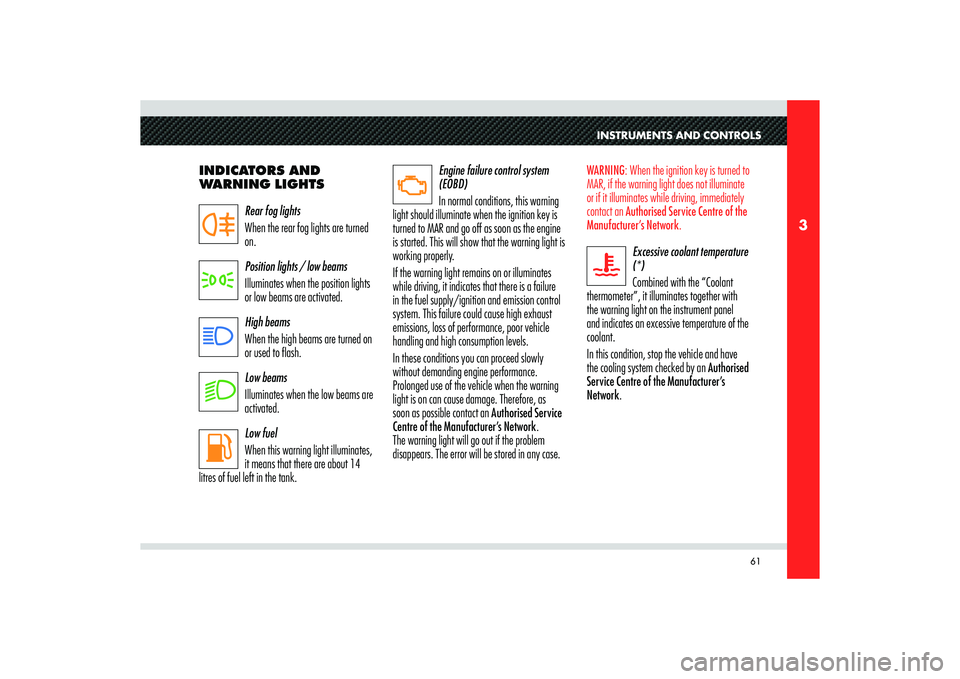
61
3
INSTRUMENTS AND CONTROLSWARNING: When the ignition key is turned to
MAR, if the warning light does not illuminate
or if it illuminates while driving, immediately
contact an Authorised Service Centre of the
Manufacturer’s Network.
Excessive coolant temperature
(*)
Combined with the “Coolant
thermometer”, it illuminates together with
the warning light on the instrument panel
and indicates an excessive temperature of the
coolant.
In this condition, stop the vehicle and have
the cooling system checked by an Authorised
Service Centre of the Manufacturer’s
Network. INDICATORS AND
WARNING LIGHTS
Rear fog lights
When the rear fog lights are turned
on.
Position lights / low beams
Illuminates when the position lights
or low beams are activated.
High beams
When the high beams are turned on
or used to flash.
Low beams
Illuminates when the low beams are
activated.
Low fuel
When this warning light illuminates,
it means that there are about 14
litres of fuel left in the tank.Engine failure control system
(EOBD)
In normal conditions, this warning
light should illuminate when the ignition key is
turned to MAR and go off as soon as the engine
is started. This will show that the warning light is
working properly.
If the warning light remains on or illuminates
while driving, it indicates that there is a failure
in the fuel supply/ignition and emission control
system. This failure could cause high exhaust
emissions, loss of performance, poor vehicle
handling and high consumption levels.
In these conditions you can proceed slowly
without demanding engine performance.
Prolonged use of the vehicle when the warning
light is on can cause damage. Therefore, as
soon as possible contact an Authorised Service
Centre of the Manufacturer’s Network.
The warning light will go out if the problem
disappears. The error will be stored in any case.
Page 64 of 223
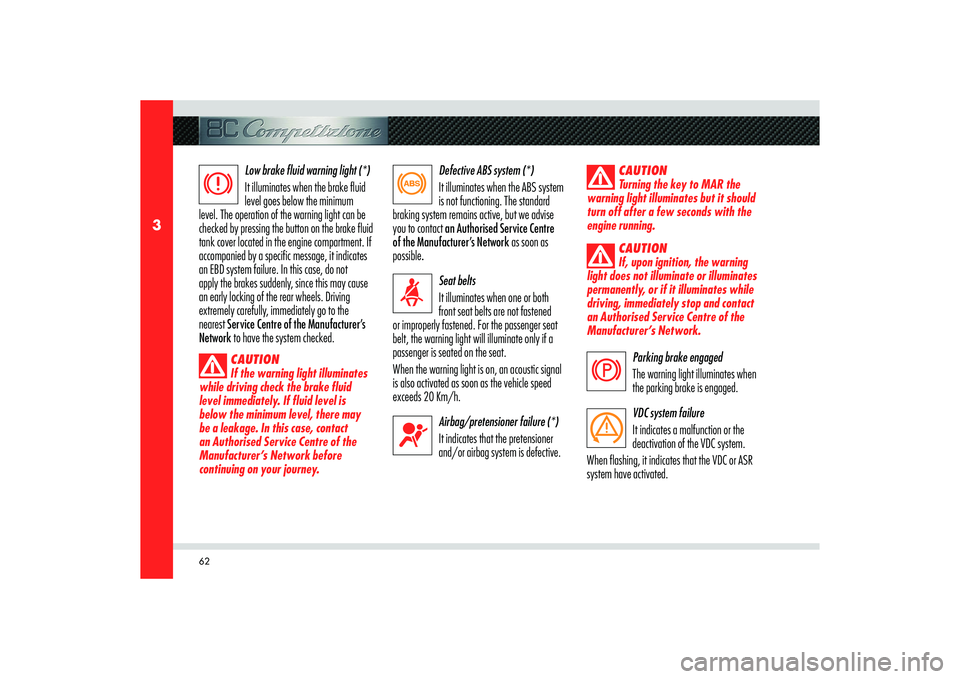
62
3
Low brake fluid warning light (*)
It illuminates when the brake fluid
level goes below the minimum
level. The operation of the warning light can be
checked by pressing the button on the brake fluid
tank cover located in the engine compartment. If
accompanied by a specific message, it indicates
an EBD system failure. In this case, do not
apply the brakes suddenly, since this may cause
an early locking of the rear wheels. Driving
extremely carefully, immediately go to the
nearest Service Centre of the Manufacturer’s
Network to have the system checked.
CAUTION
If the warning light illuminates
while driving check the brake fluid
level immediately. If fluid level is
below the minimum level, there may
be a leakage. In this case, contact
an Authorised Service Centre of the
Manufacturer’s Network before
continuing on your journey.
Defective ABS system (*)
It illuminates when the ABS system
is not functioning. The standard
braking system remains active, but we advise
you to contact an Authorised Service Centre
of the Manufacturer’s Network as soon as
possible.
Seat belts
It illuminates when one or both
front seat belts are not fastened
or improperly fastened. For the passenger seat
belt, the warning light will illuminate only if a
passenger is seated on the seat.
When the warning light is on, an acoustic signal
is also activated as soon as the vehicle speed
exceeds 20 Km/h.
Airbag/pretensioner failure (*)
It indicates that the pretensioner
and/or airbag system is defective.
CAUTION
Turning the key to MAR the
warning light illuminates but it should
turn off after a few seconds with the
engine running.
CAUTION
If, upon ignition, the warning
light does not illuminate or illuminates
permanently, or if it illuminates while
driving, immediately stop and contact
an Authorised Service Centre of the
Manufacturer’s Network.
Parking brake engaged
The warning light illuminates when
the parking brake is engaged.
VDC system failure
It indicates a malfunction or the
deactivation of the VDC system.
When flashing, it indicates that the VDC or ASR
system have activated.
Page 66 of 223
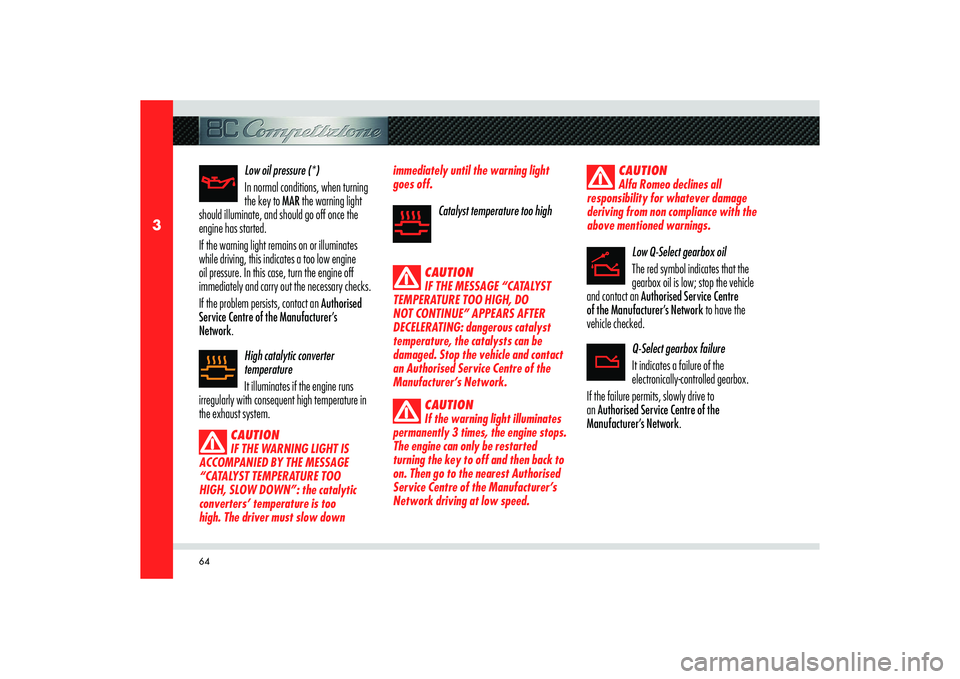
64
3
Low oil pressure (*)
In normal conditions, when turning
the key to MAR the warning light
should illuminate, and should go off once the
engine has started.
If the warning light remains on or illuminates
while driving, this indicates a too low engine
oil pressure. In this case, turn the engine off
immediately and carry out the necessary checks.
If the problem persists, contact an Authorised
Service Centre of the Manufacturer’s
Network.
High catalytic converter
temperature
It illuminates if the engine runs
irregularly with consequent high temperature in
the exhaust system.
CAUTION
IF THE WARNING LIGHT IS
ACCOMPANIED BY THE MESSAGE
“CATALYST TEMPERATURE TOO
HIGH, SLOW DOWN”: the catalytic
converters’ temperature is too
high. The driver must slow down immediately until the warning light
goes off.
Catalyst temperature too high
CAUTION
IF THE MESSAGE “CATALYST
TEMPERATURE TOO HIGH, DO
NOT CONTINUE” APPEARS AFTER
DECELERATING: dangerous catalyst
temperature, the catalysts can be
damaged. Stop the vehicle and contact
an Authorised Service Centre of the
Manufacturer’s Network.
CAUTION
If the warning light illuminates
permanently 3 times, the engine stops.
The engine can only be restarted
turning the key to off and then back to
on. Then go to the nearest Authorised
Service Centre of the Manufacturer’s
Network driving at low speed.CAUTION
Alfa Romeo declines all
responsibility for whatever damage
deriving from non compliance with the
above mentioned warnings.
Low Q-Select gearbox oil
The red symbol indicates that the
gearbox oil is low; stop the vehicle
and contact an Authorised Service Centre
of the Manufacturer’s Network to have the
vehicle checked.
Q-Select gearbox failure
It indicates a failure of the
electronically-controlled gearbox.
If the failure permits, slowly drive to
an Authorised Service Centre of the
Manufacturer’s Network.
Page 116 of 223
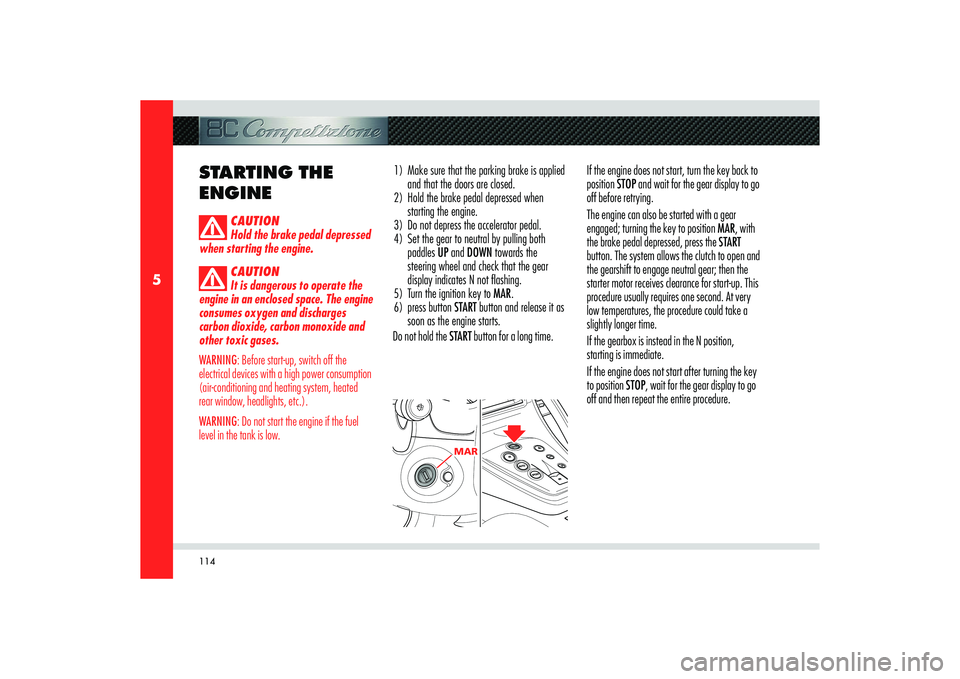
114
5
MAR
STARTING THE
ENGINE
CAUTION
Hold the brake pedal depressed
when starting the engine.
CAUTION
It is dangerous to operate the
engine in an enclosed space. The engine
consumes oxygen and discharges
carbon dioxide, carbon monoxide and
other toxic gases.
WARNING: Before start-up, switch off the
electrical devices with a high power consumption
(air-conditioning and heating system, heated
rear window, headlights, etc.).
WARNING: Do not start the engine if the fuel
level in the tank is low.
1) Make sure that the parking brake is applied
and that the doors are closed.
2) Hold the brake pedal depressed when
starting the engine.
3) Do not depress the accelerator pedal.
4) Set the gear to neutral by pulling both
paddles UP and DOWN towards the
steering wheel and check that the gear
display indicates N not fl ashing.
5) Turn the ignition key to MAR.
6) press button START button and release it as
soon as the engine starts.
Do not hold the START button for a long time.If the engine does not start, turn the key back to
position STOP and wait for the gear display to go
off before retrying.
The engine can also be started with a gear
engaged; turning the key to position MAR, with
the brake pedal depressed, press the START
button. The system allows the clutch to open and
the gearshift to engage neutral gear; then the
starter motor receives clearance for start-up. This
procedure usually requires one second. At very
low temperatures, the procedure could take a
slightly longer time.
If the gearbox is instead in the N position,
starting is immediate.
If the engine does not start after turning the key
to position STOP, wait for the gear display to go
off and then repeat the entire procedure.
Page 127 of 223
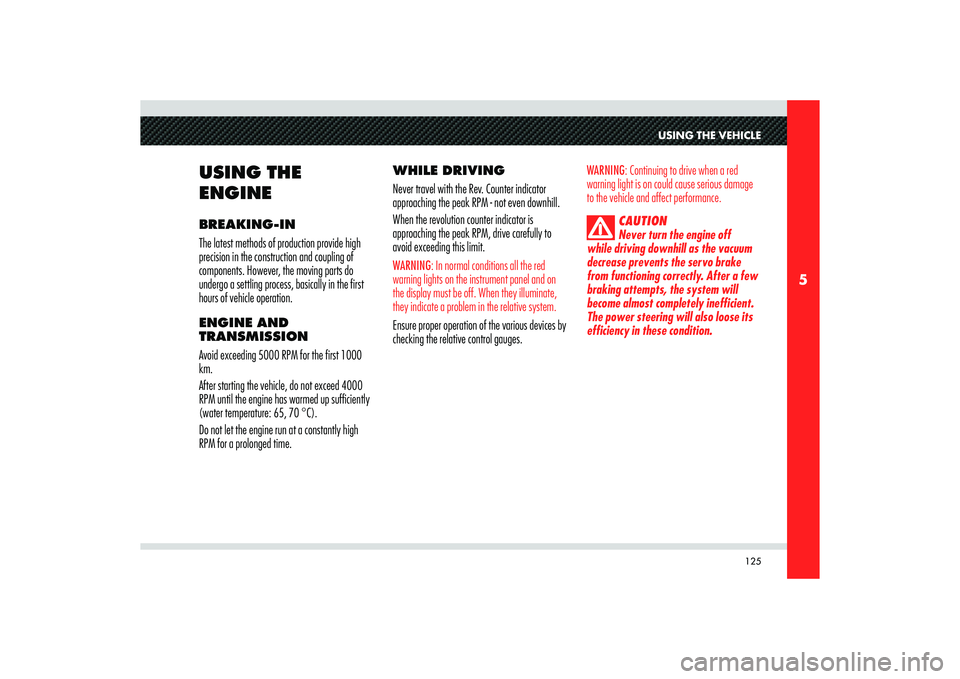
125
5
USING THE VEHICLE
USING THE
ENGINEBREAKING-IN
The latest methods of production provide high
precision in the construction and coupling of
components. However, the moving parts do
undergo a settling process, basically in the first
hours of vehicle operation.
ENGINE AND
TRANSMISSION
Avoid exceeding 5000 RPM for the first 1000
km.
After starting the vehicle, do not exceed 4000
RPM until the engine has warmed up sufficiently
(water temperature: 65, 70 °C).
Do not let the engine run at a constantly high
RPM for a prolonged time.WHILE DRIVING
Never travel with the Rev. Counter indicator
approaching the peak RPM - not even downhill.
When the revolution counter indicator is
approaching the peak RPM, drive carefully to
avoid exceeding this limit.
WARNING: In normal conditions all the red
warning lights on the instrument panel and on
the display must be off. When they illuminate,
they indicate a problem in the relative system.Ensure proper operation of the various devices by
checking the relative control gauges.
WARNING: Continuing to drive when a red
warning light is on could cause serious damage
to the vehicle and affect performance.
CAUTION
Never turn the engine off
while driving downhill as the vacuum
decrease prevents the servo brake
from functioning correctly. After a few
braking attempts, the system will
become almost completely inefficient.
The power steering will also loose its
efficiency in these condition.
Page 131 of 223
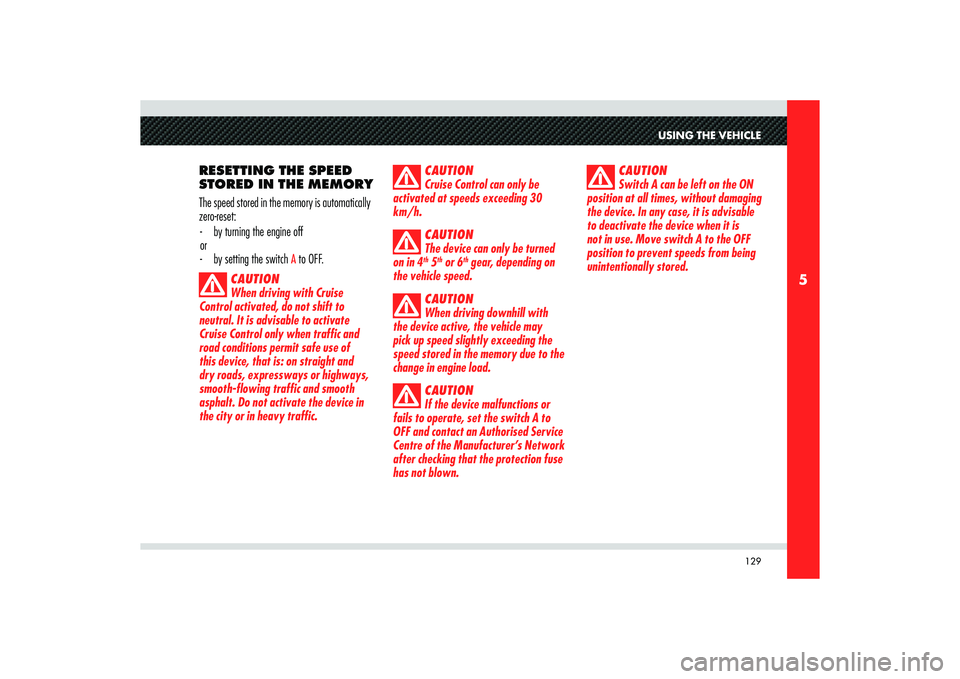
129
5
USING THE VEHICLE
RESETTING THE SPEED
STORED IN THE MEMORY
The speed stored in the memory is automatically
zero-reset:
- by turning the engine off
or
- by setting the switch
A to OFF.
CAUTION
When driving with Cruise
Control activated, do not shift to
neutral. It is advisable to activate
Cruise Control only when traffic and
road conditions permit safe use of
this device, that is: on straight and
dry roads, expressways or highways,
smooth-flowing traffic and smooth
asphalt. Do not activate the device in
the city or in heavy traffic.CAUTION
Cruise Control can only be
activated at speeds exceeding 30
km/h.
CAUTION
The device can only be turned
on in 4
th 5th or 6
th gear, depending on
the vehicle speed.
CAUTION
When driving downhill with
the device active, the vehicle may
pick up speed slightly exceeding the
speed stored in the memory due to the
change in engine load.
CAUTION
If the device malfunctions or
fails to operate, set the switch A to
OFF and contact an Authorised Service
Centre of the Manufacturer’s Network
after checking that the protection fuse
has not blown.CAUTION
Switch A can be left on the ON
position at all times, without damaging
the device. In any case, it is advisable
to deactivate the device when it is
not in use. Move switch A to the OFF
position to prevent speeds from being
unintentionally stored.